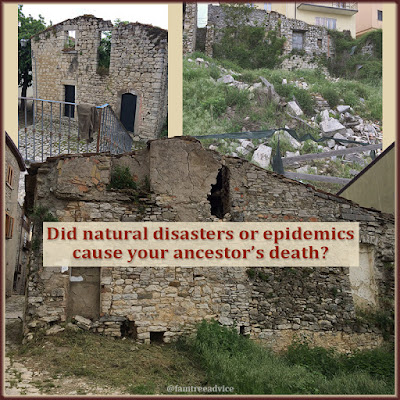Estimates in your tree can help you avoid mistakes. See where they belong.
Family Tree Analyzer is a wildly useful, free program for genealogists. Each time I run it, I find something else I want to do with it.
Here's what I'm going to do with Family Tree Analyzer today.
 |
| This free tool offers countless ways to find the errors or missing info in your family tree. |
A while ago, I created a policy to follow with my family tree. Every individual in my tree needs to have an estimated birth year and at least a country of birth. If I don't know when someone was born, I can:
- give them about the same birth year as their spouse
- subtract 25 from the year their oldest known child was born
- add 25 to their younger parent's age
Enter an estimated age in your family tree as "about" whatever year. Family Tree Maker, the genealogy software program I use, automatically abbreviates about as "Abt". Your software may handle this automatically, too.
Note: Whenever I enter an estimated date, I do not add a source. That way I know my own policy is the only source.
With an estimated age in your tree, you won't set someone born "Abt 1800" as the parent of someone born in 1920. It can also help you decide which of the 13 men named "Giovanni Pozzuto" in your tree is the one you're looking for. (And that's not counting all my Giovannantonio Pozzutos!)
Adding each person's likely country of birth and death is helpful, too. It can prevent a mix-up between a family that came to America and one that never left their mother country.
Family Tree Analyzer (FTA) makes it easy to see who in your family tree is missing a birth year and country. First, go to ftanalyzer.com to download the latest PC or Mac version. Launch the program and open your newest GEDCOM file. (I just realized you can drag and drop your GEDCOM into the FTA window!)
Once FTA loads your file, click the Main Lists tab. You may see a lot of empty fields in the BirthLocation and DeathLocation columns. In the BirthDate column, look for the word UNKNOWN.
 |
| Family Tree Analyzer helps you find everyone in your tree with no birth date—not even an estimate. |
I've been on a roll lately, adding dozens and dozens of babies from my grandfather's hometown to my tree. So I have more than 22,000 people in my family tree. To make this task easier with such a big tree, I can click any column name in FTA to sort the results.
If I click the BirthDate column, all my UNKNOWNs group together. I'm happy to see I have only 11 of them. Those are usually people I added in a hurry, or while the dog was begging me for peanut butter. I can check all 11 people in my family tree and calculate their estimated birth year. It didn't take long for me to apply my rules and give each of the 11 people an estimated birth year and country.
Next, if I click the BirthLocation column in FTA, all the blank fields group together. Oh no. I've got tons and tons of blank birth locations.
When it comes to adding an estimated country of birth or death, there may be times when you want to keep it blank. Was the oldest child in a family born before or after the parents migrated? If you're not sure, you should leave it blank. Otherwise you might think you shouldn't look for that child on a ship manifest.
That's why I made another policy for the estimated birth or death country. If it's before 1850, I feel safe in assuming my relatives were born and died in Italy. There wasn't a lot of trans-Atlantic migration going on at that time. And my hometowns are so remote, and were so poor, that taking a ship somewhere wasn't an option then. I can assume my Angela Bianco—born in 1772 and died in 1836—was only ever in Italy. I may not be positive which town she was born in, but I feel sure it was in Italy.
Adding these unsourced estimates can help you avoid errors. And it tells FTA not to look in the Canada, Ireland, US, or UK Census for someone who was born and died in another country.
My own list of empty places of birth is overwhelming. It's something I've been more careful about recently. And I fix it each time I find someone with a blank location. Family Tree Analyzer is a good motivator for me to do a better job with so many aspects of my family tree. What can it show you today?



